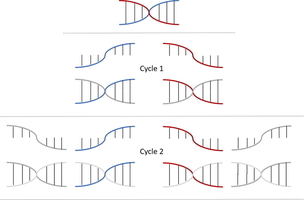PCR - Photocopying Genes
Posted in Techniques Examined • Tagged with Introductory
PCR is a common technique used to amplify specific regions of DNA. Put more simply, its a process that allows us to create copies of a piece of DNA. There are two main properties of PCR that we take advantage of - amplification (getting many copies) and isolation (of a single region).
If you understand the basic idea of photocopying, then you can understand PCR.
 I should note that the role of PCR has changed over time and I will mostly be focusing on the current use. Additionally, there are several variants based off the standard PCR, including rt/qPCR, but those will be covered in a different post.
I should note that the role of PCR has changed over time and I will mostly be focusing on the current use. Additionally, there are several variants based off the standard PCR, including rt/qPCR, but those will be covered in a different post.
Why do a PCR?
Typically PCR is just a step to let us do something else with a gene or region of DNA. It is the first step in gene cloning or for things like gene editing. It can also be used ‘genotype’ an individual for a gene, i.e. figure out which specific copy of a gene someone has.
Terminology
| PCR | Polymerase Chain Reaction |
| Nucleotide1 | a base (A, C, T, or G) found in DNA |
| Polymerase | a protein that does the ‘work’ of making copies |
| Primer | a ‘starter’ sequence to help the polymerase get going on each copy |
| Template | the ‘original’ that the polymerase uses to create a copy |
How does PCR work conceptually?
PCR is basically just a photocopy with zoom feature. In both cases, you have to start with an ‘original’ copy, which we call a template. However, the cellular machinery that does the copying doesn’t know how to get started making the copy with a blank page. So we give it the equivalent of a dot of ink at the start of a line, called a primer, that lets the copy get started.
| Start | Machinery | Basic Materials | |
|---|---|---|---|
| Photocopy | Original | Photocopy Machine | Ink & Paper |
| PCR | Template | Polymerase | Nucleotides & Primers |
Technical Limitations
Because we provide the primers, we need to know at least some sequence around whatever is being PCR’ed.
-
sometimes referred to as a dNTP, which specifies that its for DNA not RNA ↩